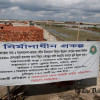Rampal Power Plant: Fly ash a big threat to environment

The fly ash to be generated from the Rampal coal-fired power plant has the potential to cause “substantial” damage to the environment, say experts.
They also pointed out the tender document does not clearly specify how exactly the contaminants of the fly ash will be prevented from leaching.
"It [fly ash] will react with water. The contamination from the fly ash will be inevitable", said an expert reviewing the environmental risks associated with coal ash disposal from the proposed 1320 MW Bangladesh- India Friendship Power Company Ltd. (“BIFPCL”) coal-powered plant.
Charles H Norris, a Denver-based geoscientist and hydrologist who has been working in the field for the last 40 years, made the assessment in response to a request made by the National Committee for Saving the Sundarbans (NCSS) headed by advocate Sultana Kamal.
He reviewed the part of the tender documents that deals with handling of coal ash section from the Environmental Impact Analysis for Rampal and the BIFPCL project layout map.
He thinks the Rampal site located on a river bank in a flood-prone area itself is inappropriate for such a project.
"Even for the ash contained within the dyke, this site is inappropriate. The site is minimally above sea level. The area is subjected to both typhoon-driven storm surges and tsunamis. Both of these known risks will become worse -- to unknown degrees -- due to climate change and rising sea levels," the expert added in his remark.
Norris's work experience includes areas of performance, oversight review, or management of site assessment, computer modeling of fluid flow, contaminant transport, and geochemistry, and aquifer evaluation.
"In my opinion, the potential for environmental damage is substantial both from the lagooned /dyked facility that is proposed and from the 'utilization' of fly ash over an area of 1414 acres without any apparent containment," he remarked in the statement.
There is nothing provided with respect to what will constitute the "utilization" across the 1414 acres that "will be developed gradually with generated ash," the report said.
“Norris said, “…disposal of ash by ponding and uncontained 'development' of broad expanses of land with fly ash is an inherently bad idea as it poses a substantial environmental risk.”
The tender documents do not allow a meaningful assessment of the chance or likelihood of environmental damage from the lagooned ash disposal. There is no useful characterisation of the site or specificity of the proposed design that allows assessment, he said.
These documents are at most qualitative with respect to the design, and little more than conceptual.
Norris's report says fly ash will react with water and toxic pollutants from the ash have the potential to contaminate ground water.
But the tender document does not contain any chemical characterisations of the ash nor does it describe how to handle those chemicals.
"If that leachate is not contained, environmental contamination occurs," it states. Leachate is produced when water passes through any matter and extracts soluble or suspended solids from the matter.
When asked about the report Dr Abdul Matin, joint convener of the National committee for saving the Sundarbans, said they have been demanding the government for scrapping the Rampal treaty as it would destroy the Sundarbans.
The government has been saying there was no scientific basis for such claims.
"So we requested this expert to review the tender document," said Dr Matin. He also sought attention of the prime minister and requested her to reconsider the decision of the Rampal power plant.
Activist and engineer Kallol Mustafa who has also been analysing different documents of Rampal power plant and finding the loopholes of safety measures of Rampal power plant said the issues underlined by Norris regarding coal ash disposal were indeed of major concern.
“From the very beginning we are highlighting the risks of ash disposal in an ash pond by the river Pasur given that the area is flood and cyclone prone,” says Mustafa.
There are instances of ash spill from coal power plants even in technologically developed countries. Notable among them are Dan River Coal Ash Spill on February 2012 from the power plant of Duke Energy, USA and Kingston Fossil Plant coal fly ash slurry spill in December of 2008 in to the Emory and Clinch River, Mustafa said.
Dr Ainun Nishat, eminent hydrologist and environmentalist, said whenever protesters or campaigners come up with a criticism, the government would come up with a solution.
“But concern is whether what the government says would be followed during the construction phase and also maintained in the long run. Who is going to give us that assurance that everything will be followed exactly in the same way even after five years,” said Dr Nishat.
The Unesco, a specialised UN body, also expressed concern over the Sundarbans at least three times in the last two years for its “Outstanding Universal Value.” In a report titled “Report on the Mission to the Sundarbans World Heritage Site, Bangladesh” after the visit of the Unesco reactive mission to Bangladesh last March, it expressed their concerns about the management of coal ash.
The Unesco report said, this ash has high risk of containing various toxic metals including arsenic, lead, mercury, nickels, vanadium, beryllium, barium, cadmium, chromium, selenium and radium all of which may cause serious damage to human and the environment. Mercury is a potent neurotoxin that reduces intelligence and otherwise impairs the brain development of infants and children, and has been linked to heart problems. After leaving the smokestack, the mercury falls to earth and accumulates in water bodies and subsequently in the tissues of fish and of people and wildlife that consume those fishes.
Ruling out any possibility of harm from the nearly one million tons of fly ash to be generated annually, the environment minister, Anwar Hossain Manju said, "Fly ash would not harm the Sundarbans, rather it will help us. There are many cement factories in Mongla and those have been using fly ash for long time. The fly ash is not harmful," he said.
“Currently our cement factories are using fly ash imported from India. They will be able to use fly ash generated from Rampal,” the minister said.

 For all latest news, follow The Daily Star's Google News channel.
For all latest news, follow The Daily Star's Google News channel. 












Comments